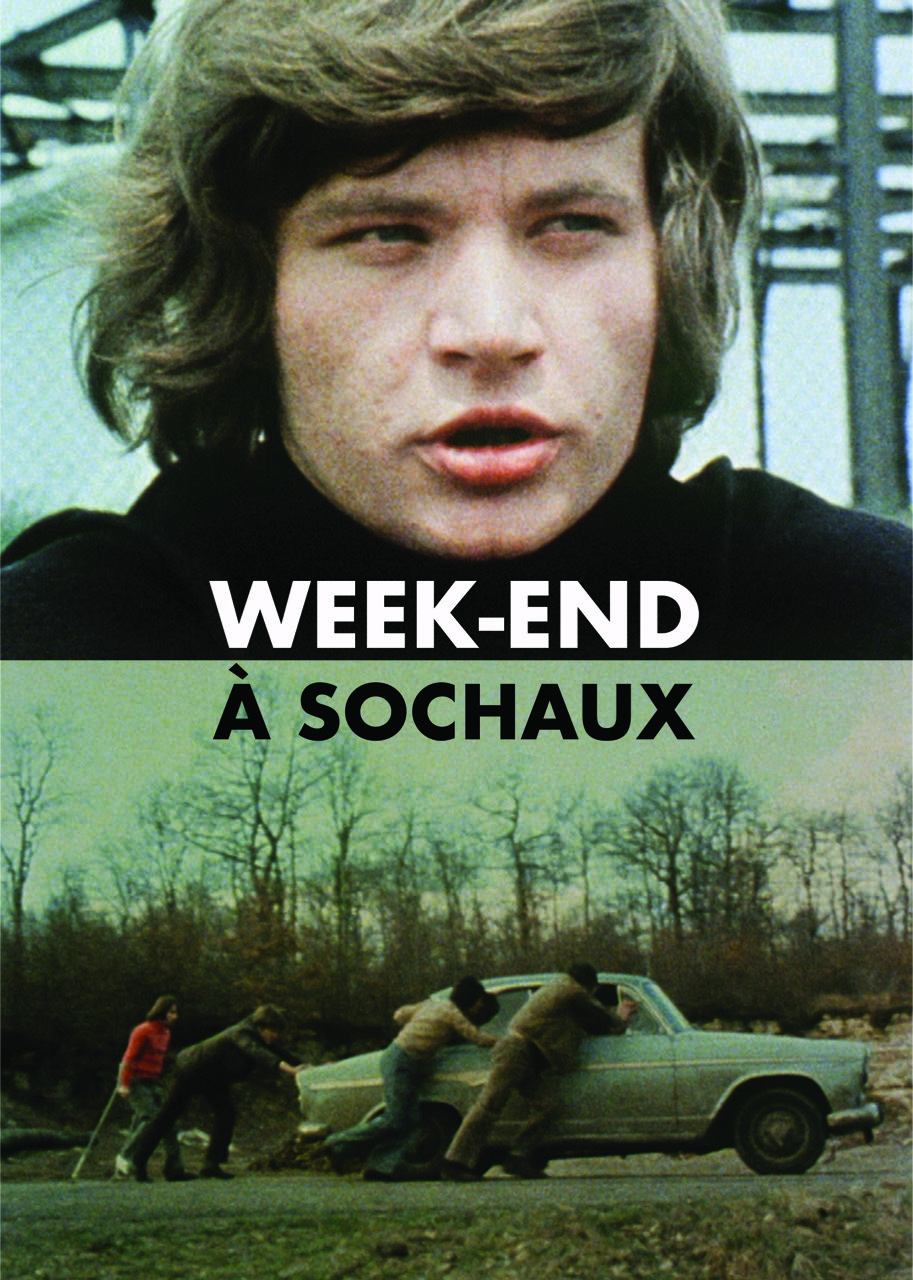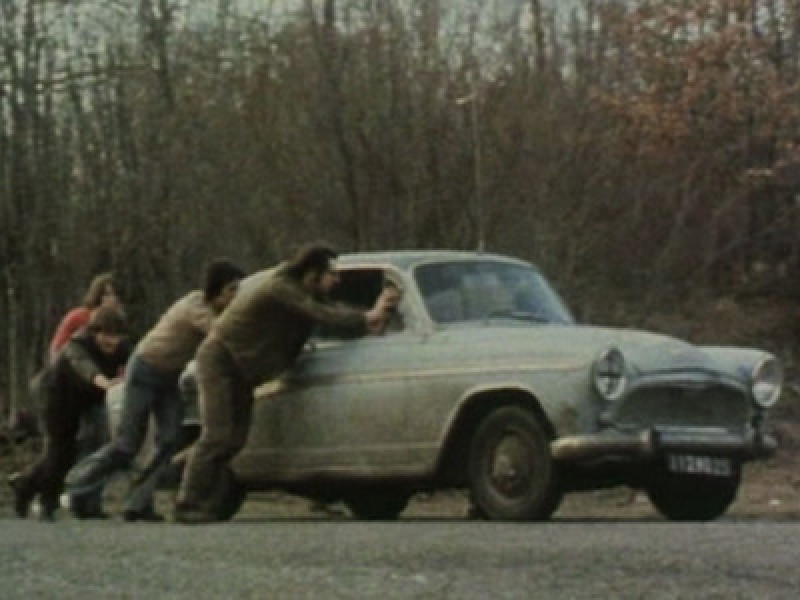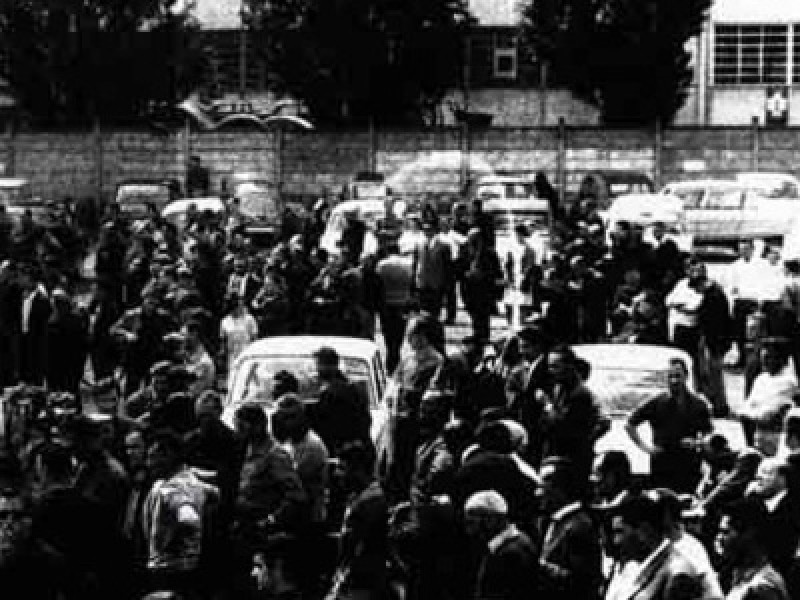Groupe Medvedkine
History of an encounter : cinema technicians and factory workers
1967-1974: These are the dates of “this period unlike any other”. Like Chris Marker in Le Fond de l’air est rouge, this could be said from the year of Vietnam (but also of the shipyard strike in Saint-Nazaire) to the year of fascist rule in Chile (but also when Giscard and the new
bosses came to power).
1967-1974: Between the March strikes at Rhodia in Besançon and work standardisation at the Peugeot factories in Sochaux, there occurred–under the impetus of Chris Marker and his friends–the constitution and action of the “Medvedkin Groups” for producing, directing and distributing political films. What about these films? Rising up against total lack of action, dreams realised of a meeting between workers and intellectuals, moving around from Paris-province-province-Paris, true values of discussion opposed to ordinary discussion of commercial value, return of the camera to the factory after years of absence (since probably about 1936), incarnation of belief in the power of cinema, in its ability to change the world, at least the images of the world, critical images and critical of images. Idea (or utopia) that the cinema is not always behind the times and that it can sometimes like the brother Lumière’s locomotives or the Medvedkine cine-train just arrive on time and exceptionally ahead of time. Thus, À bientôt, j’espère–title slogan dealing the
ruling class a real blow–the first film in the series was shot six months before May 1968 and shown in April.
1967-1974: From À bientôt, j’espère to Avec le Sang des autres, including Classe de lutte, Rhodia 4×8, Images de la Nouvelle Société, Le Traineau-Échelle, Sochaux 11 juin 1968, Les 3/4 de la vie, Lettre à mon ami Pol Cèbe, Septembre chilien and Week-end à Sochaux. If the very first film is still a militant film on working class conditions, Classe de lutte, the second one, is already a militant worker film. Sliding, shifting, quivering, the train rolls on portraying the reversal of perspective and the key idea: no longer focusing on the view (if there is a view) of ethnologist, entomologist and Parisian and teaching the object/subject how to appropriate the tools for their own portrayal: camera, tape recorder, editing and projection. This is so rare a moment when the cinema-tool is decentralised, the cinema-machine serves other interests, the cinema-trade sheds its professionalism and the cinema-art shakes up its foundations. In a nutshell, a fleeting moment in time, when cinema operates without licence and with a free hand. And when normality was restored by force, there still remains, like a deposit, the trace of an idea, films made by others, films made in another way.
1967-1974: Seven years of images, writings and struggles, seven years of reflection mingled with action, seven years of unheard of cinematographic experiment, nothing less than cinema set up in the factory–an experience which deserves to be frozen in time and made into history like that for example of French cinema which was wrong to do so well without it up to now. This attempt was carried out far from Paris, even if the capital breathed life into the two movements–Besançon and Sochaux–an adventure born from even further afield (the spirit of the Resistance, People and Culture), fuelled by May 1968, the iconoclastic advent of worker-filmmakers, camera strapped to their wrist and tape recorder strung across their shoulder. What are the Medvedkin Groups, if not a revolutionary trial cinema? So why did they call themselves “Medvedkin”, if not to make the connection between the name and the spirit of an old Bolshevik filmmaker, who entirely taken up with faithfully serving the socialist cause, also put his entire studio on rails so that cinema could meet the workers?
Je est un auteur (self-authoring). And after coming out of the mines or the factories, how to explain the longevity, or rather persistence, despite working nights, pressure of the bosses, trade union distrust, indifference, heavy burden of daily life, deep-rooted feeling of cultural inferiority, risk of dissension, violence of divisions, fatigue and exhaustion? How do you explain that men and women kept their expression at arm’s length for such a long time? Going beyond the driving forces of certain figures (such as, Chris Marker, Pol Cèbe, Antoine Bonfanti and Bruno Muel), beyond the strength of examples provided by some others (prestiges of René Gautier, Joris Evens and Jean-Luc Godard), and beyond the vital relay of the production structure (Slon), the response has to lie in the truth of a form: form of the organisation and form of films.
The Medvedkin Groups should be thought of as a free association. Freed first of all from obedience. Even if the worker-filmmakers all belong to the CGT, their films do not toe the union line. The impetus has always come from one of them, an immediate reaction to an event or a scandal, conveyed by brother filmmakers and at no time–far from it–being from the union or party. As the expression goes, these films have “no Lord and no master”. They owe their origin to expression of rage, words to be reiterated, thirst for knowledge and to share knowledge. The Medvedkin Groups’ works are not so much propaganda films, as films of revolt, precisely tying in with Medvedkin the man who peppered each of his Soviet films with intertitles–leitmotiv: “Comrades, this can no longer continue!” “Comrades, it needs to change”.
A free association for free association, as the Freudians say. Freedom to associate, to approach people, forms, genres, formats, techniques, practices, freedom to film the forbidden, to take up the words of the powers that be and strip them bare. Militant cinema, without a doubt and therefore different. But also completely different from known and identified militant cinema. Inventive cinema experimenting within the same film with the virtues of jump cuts and the broadcast of direct speech, associating fiction and reconstruction (Week-end à Sochaux), the precursor of what was not yet called a clip (Rhodia 4×8), a hotchpotch of humour and satire, collages, caption stands, essay, blackouts, tracking and zoom, combining Super 8 and 16 mm, colour and black and white (Sochaux 11 juin 68), diverting images and sounds to critical or personal if not intimate ends (Le Traîneau-Échelle, Lettre à mon ami Pol Cèbe). From one film to another, never or virtually never is the team identical, even if some of the names come back all the time. From the subject itself a form can be deduced which is not afraid of inventing itself each time. If the causes for taking action make sense and history, the Medvedkin Groups have this going for them that they don’t aim at precise objectives but are thus free to achieve others. Concerning effective militant production, Le Traineau-Échelle by Jean-Pierre Thiebaud, Lettre à mon ami Pol Cèbe by Michel Desrois and even Classe de lutte because it is (above all) a great love film, certainly go off the subject! However, they reach the ideal horizon of militant cinema even going beyond it. Is it merely by chance that the images and commentary in Traîneau are on intimate terms with the stars, radical low-angle shots or Jacob’s ladder for vertical cinema on materialistic earth? Is it just by chance that the three men in Lettre à mon ami Pol Cèbe get into a car which is dashing along the motorway like a runway for an announced destination and lost in the night (Lost Highway)? Is it by chance that this cinema is Icarian? Is it formalist exaltation or accession, when you’re least expecting it, to self-expression? What is this formalism here but exactly what is needed: political aesthetics for poetic revolution. On the very cutting edge, the Medvedkin Groups’ cinema takes up or continues without a shadow of a doubt an art movement that Jean-Louis Comolli described in his critique of Loin du Vietnam–films of a transitional period going between the end of the New Wave and commitments to come. The film was deliberately shown in Besançon itself before any other place and seen that evening by the Medvedkinians of tomorrow: “The first merit of this collective work is to affirm and even exacerbate the individuality of each of these craftsmen. The Vietnam in the film is more than just a pretext: it is the ideal place where each person identifies the most with himself. Resnais with Resnais and Godard with Godard, of course both of them show their self-portraits based on this sponsored work–going back to the very old idea that there is no detour that doesn’t take you back home more safely than a great detour, no mirror more obligingly faithful than the most distant and whose reflection goes through the greatest otherness. We thought that the anonymous persons of Art operated like this, depicting themselves as God in cathedrals, as an apostle or an angel. […] How astonishing to find that here it is a question of life and death, poetry and cinema, and not so much about American aggression […] since–we start to understand it and that is not the least important lesson of the film–it is not possible for a filmmaker to speak of the world other than by making it into his own1. And doesn’t this hint at what Rivette had already identified when viewing Voyage in Italy by Rosselini and The Lusty Men by Nicholas Ray in the fifties: the birth of autobiographical cinema turning to I. A strange, unusual and logical turn instead of using we, so that the political view of the author remains valid in the broader version… while inversely other well known filmmakers were claiming for their names to be diluted within the Collective (Godard and the Dziga Vertov Group).
Labour force. As individual cinema of the Medvedkin Group, its films bear the trace of everyone’s development, a development which in turn could only go through cinema and the nature of its forces. Originally, it was about describing trauma. In Les 3/4 de la vie, Peugeot workers talk about the organisation and regulations for households, with deliberate separation of men and women and of French and immigrants in different buildings. Avec Le Sang des autres dismantles the assembly line divided into a succession of an FO union member, a CGT union member, a Moroccan, a Frenchman, an Algerian, everything that builds up isolation and separation. In other words, systematically cutting individuals off from one another, each one being himself divided by fragmented, split and incomplete work. Later, a worker talks about how his hands are so sore at the end of the day that he cannot touch his girlfriend’s body. Nouvelle Société n° 7 places the emphasis on accidents, featuring a severed hand. The question about hands is the big, founding question, sounding like an obsession in Lettre à mon ami Pol Cèbe and running through almost all the films of both groups, because the hand makes the man and the hand makes the film.
And indeed the staging of managers has but one aim: preventing the blood from running and clogging into a group that would obviously be compatible (the M+:M type, like Medvedkin); it aims at moving each one away from the other and even further, in the individual, at moving the head away from his body, mind and hand. Like the quartering, mutilating and updating of an archaic dismembering to the benefit of a rising productivity curve. Then what can cinema do and what does it do? It sticks, sutures, mends, brings closer (“attraction montage”) and joins visually, heals and thinks the link between facts and combines them. The cutting hand, as opposed to the hand being cut. When the opening scene of Classe de lutte is set in the cutting room, it does imply a lot but namely that a film is the opposite of scattering, the place of consolidation, it is the mending of torn human tissue. Between the eye and the hand, it’s like the chicken and egg situation, but when, in the 30s, the Russian farmers and miners looked at themselves on screen straight in the eye and when Peugeot workers go from developer to car inspection, there is a long hoped for revolution (at least the inner one): from the eye to the hand, and vice versa, the body is back in motion. In October 1917, the Markerian commentary in The Train Rolls On said: “the hands take over from the eyes”. In Paris in 2002, Henri Traforetti, Medvedkin Group activist from the beginning, claimed again: “holding a camera in my hand opened my eyes”.1 And it circulates like the train, like blood that cannot lie, two shots edited together also link up the chain, and for once, we begin to hope that hands will no longer be “fragile” or “severed”2, but rather powerful and fair. In Lettre à mon ami Pol Cèbe the voice-over on board the “filmmaking car” whispers: “It is no coincidence that the word humankind also contains the word hand.” And almost thirty years later, Godard’s voice replies like an echo: “… There are those who think and those who act, say some, but the true condition of man is to think with his hands3”
Bernard Benoliel (L’Image, le monde no 3, automne 2002, Éditions Leo Scheer)
NB: According to INSEE (French Survey Institute) there are 7,200,000 workers (skilled and unskilled) in French industries today. Where is the cinema representing them? Who listens to their voice today?
1. Speech at Paris I University, seminar organised by Nicole Brenez, 26 February, 2002.
2. Fragile Hands and Severed hands are the titles of the two parts making up Le Fond de l’air est rouge.
3. Le Contrôle de l’Univers, Chapter 4a in Histoire(s) du cinéma. Shortly before, you can hear the disturbing echo:
“The spirit is only true to itself when it manifests its presence and the word manifest originates from the Latin for hand”.


